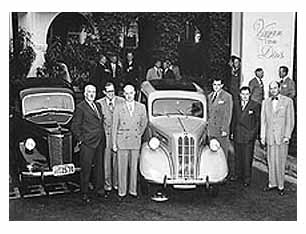Who wants to hazard a guess as to how many little 1949 Ford Anglias (English Fords) were in the United States in 1954? Much less, how many of them might have been found in the rural midwest? Darn few, right?
I ran across a genuine curiosity the other day while going through the original 1954 sales records of vehicles sold at Palma Motors in Paris IL, Dad's dealership.
On April 16, 1954, they sold a new Willys Universal Jeep to one Elmer Malone of R.R.2, Chrisman, IL.
Pricing was as follows:
New 1954 Willys Universal Jeep, Serial #454-GB2: $1,488.75
Options: Heater: $24.96
Draw Bar: $10.02
Front Top: $72.20
Extra Seat: $21.61
Freight: $35.00
Sales Tax: $24.00
Total Delivered Price: $1,676.54
Settlement was as follows:
Cash on Delivery: $1,224.00
Trade-in Allowance: $452.24
Trade-in: 1949 Ford Anglia, Serial #C37312
Now, that was one early postwar English import! And yet, here it was in the middle of the midwest on some guy's farm, miles from the major metropolitan areas where "little furrin' cars" first invaded our shores after WWII. In fact, I'd be surprised to learn that any 1949 Anglias were imported, but they obviously were..."Farmer Malone" sure didn't dismantle this one and bring it back with him from military service in Great Britain!
Anyone know something about English Fords being imported that early? Quite a curiosity, it would appear. BP
I ran across a genuine curiosity the other day while going through the original 1954 sales records of vehicles sold at Palma Motors in Paris IL, Dad's dealership.
On April 16, 1954, they sold a new Willys Universal Jeep to one Elmer Malone of R.R.2, Chrisman, IL.
Pricing was as follows:
New 1954 Willys Universal Jeep, Serial #454-GB2: $1,488.75
Options: Heater: $24.96
Draw Bar: $10.02
Front Top: $72.20
Extra Seat: $21.61
Freight: $35.00
Sales Tax: $24.00
Total Delivered Price: $1,676.54
Settlement was as follows:
Cash on Delivery: $1,224.00
Trade-in Allowance: $452.24
Trade-in: 1949 Ford Anglia, Serial #C37312
Now, that was one early postwar English import! And yet, here it was in the middle of the midwest on some guy's farm, miles from the major metropolitan areas where "little furrin' cars" first invaded our shores after WWII. In fact, I'd be surprised to learn that any 1949 Anglias were imported, but they obviously were..."Farmer Malone" sure didn't dismantle this one and bring it back with him from military service in Great Britain!
Anyone know something about English Fords being imported that early? Quite a curiosity, it would appear. BP
 We've got to quit saying,
We've got to quit saying, 


Comment